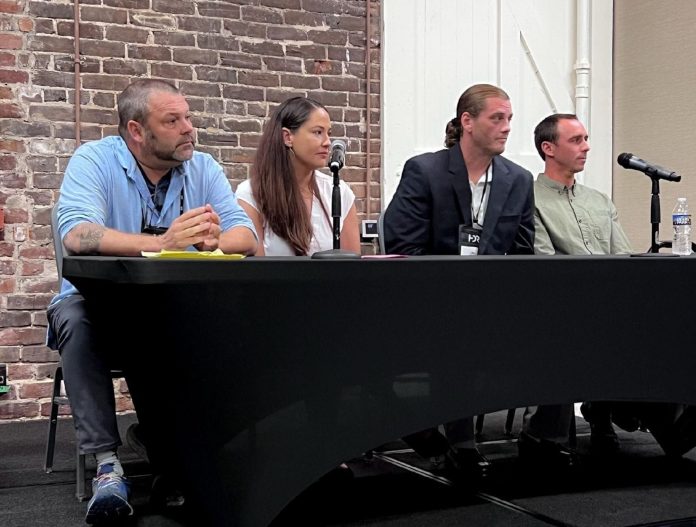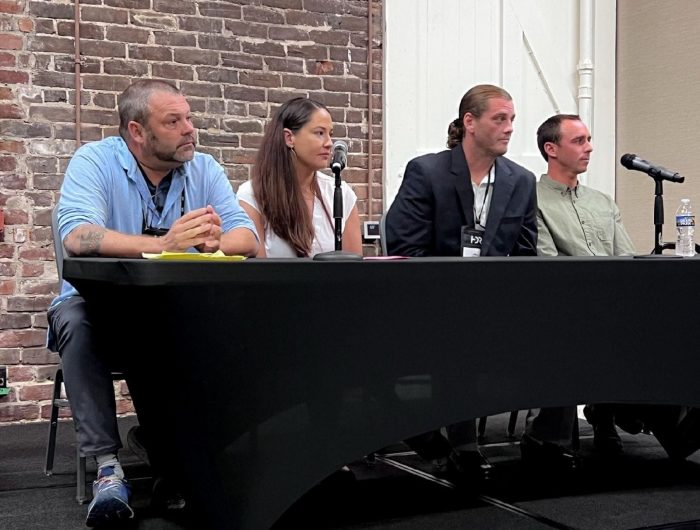
For Hatteras Islanders, the issues stemming from a former military base at Buxton Beach have been obvious for the past 14 months.
Residents have been able to see and smell the situation on a routine basis, from the petroleum that resurfaces with heightened erosion, to the exposure of foundations, cables, and pipes that were left behind after the Navy and Coast Guard departed the site years ago.
But the Buxton Civic Association (BCA) introduced the situation to an entirely new audience at the annual North Carolina Beach, Inlet and Waterway Association (NCBIWA) Conference last week, generating an overwhelming response and a new wave of momentum for the next beach stabilization steps.
The BCA joined the NCBIWA shortly after forming in April 2024, and was the first Hatteras Island-based group to become a member.
The NCBIWA is “dedicated to preserving, protecting and enhancing the North Carolina Coast by merging science and public policy in order to create a sustainable and resilient coast,” according to its website, and the organization works “on behalf of our members by encouraging government action and funding, educating and advocating for effective Federal and State policy, and facilitating environmentally sound scientific and engineering solutions for our threatened beaches, inlets and waterways.”
Dare County Manager and Attorney Bobby Outten is the current NCBIWA Chairman, and the organization includes dozens of local, state, and federal government agencies, engineers and consultants, legislators, and basically groups who have a stake in the state’s coastline.
What the BCA had to say at the conference…
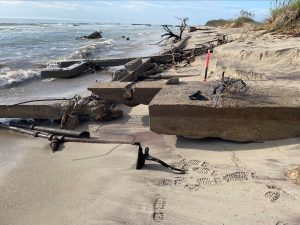
The BCA hosted a presentation early on in the two-day conference entitled “History of Buxton, North Carolina,” with a four-person panel that included BCA board members Brian Harris, Heather Jennette, and Jeff Dawson, and famed local surfer and Buxton Beach advocate, Brett Barley.
The BCA’s morning presentation followed a short series of presentations by state and local agencies – including the U.S. Army Corps of Engineers (USACE) – and the BCA addressed an audience of more than 200 NCBIWA members and attendees.
Harris and Jennette started by outlining the formation of the BCA, (which took place just months earlier), and then Jennette explained the history of the roughly 50-acre Buxton Formerly Used Defense Site (FUDS) property.
The background is well-known territory for Hatteras Islanders, but for the conference attendees, Jennette outlined how a small section of Buxton Beach at the end of Old Lighthouse Road has been closed to the public for over a year after two offshore hurricanes eroded the shoreline in September 2023 and revealed leftover infrastructure from a 1956-2010 military base, as well as sporadic but strong petroleum smells.
Because the Buxton Beach site is part of the FUDS program, the USACE is responsible for addressing the petroleum contaminants related to Navy activity from 1956-1982, while the U.S. Coast Guard is responsible for other potential contaminants from their use of the site from 1985-2010.
Debate continues on which agency will purposely clean up all abandoned infrastructure, and will spearhead proactive steps to stabilize the beach, outside of an upcoming 2026 Buxton Beach nourishment project already planned by Dare County.
This left-behind debris was an original flashpoint for the BCA, which has persistently insisted since its inception that a fully-remediated Buxton shoreline was the ultimate goal.
There was certainly some good news to report during the presentation, however. A year after the problems surfaced, the USACE announced in September 2024 that they were launching an immediate response action to address the petroleum, which included hiring a contractor to remove contaminated soils in order to mitigate the petroleum release.
The contractor’s excavations began on October 2, and since then, the contractor has removed a promising amount of petroleum-impacted soils and water, leftover concrete, old pipes, and other metallic debris.
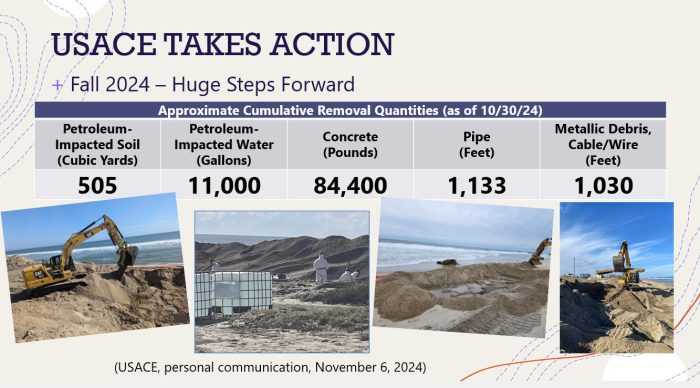
This current project will last for 60 days, according to an October 9 press release from the USACE, with a focus on seven connected areas along the oceanfront, which is where the bulk of abandoned debris and petroleum smells have been identified. A comprehensive soil and groundwater sampling event by USACE is next, and will hopefully provide more guidance on future remediation efforts.
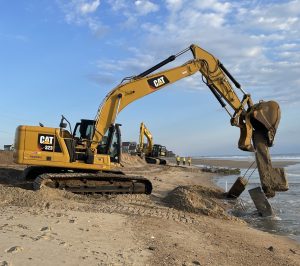
Jennette mentioned in the presentation how this latest surge in USACE activity brought relief and optimism for the BCA, which was used to months of minimal action, prior to September 2024.
“The little asterisk that gave us some life is that if structures were in the way of the environmental remediation, [they would remove them]. Fortunately, that’s what has happened,” said Jennette.
“They have removed significant amounts of impacted soil, water, and concrete pipes. We’re really, really thankful to the [USACE] Savannah District, to Colonel Sturgeon, and to the county for making this happen. It’s not fixed; it’s not totally resolved, but [we’re miles] from where we were in August, so we feel very fortunate.”
Dawson spoke next, and outlined the many man-made adjustments that have affected the Hatteras Island shoreline in the past century.
Terminal groins at Oregon Inlet, routine dredging at Hatteras and Ocracoke Inlets, and especially the island-long line of dunes that were created during the Great Depression have forcibly reshaped the shoreline over the decades, according to Dawson.
“I think the most damning thing is that we’ve allowed or maintained a dune line for the 47 miles of Hatters Island that effectively acts as a sea wall, which reflects the energy and causes a scouring [of the beach.] And that is what is happening now.”
With this preliminary background information explained, the four-member Buxton panel stated that their eyes were already turned to the future, and to deeper, long-term solutions.
This is where replacing the Buxton jetties enters the conversation…
One of the future goals of the BCA is to repair – or more likely replace – the three Buxton jetties that were built by the Navy in the early 1970s to protect their military facilities. However, there are some hard and fast laws when it comes to adding permanent structures, like jetties and groins,* on any North Carolina coastline.
For decades, it has been the policy of North Carolina, as outlined in the Coastal Area Management Act, to ban hardened structures along the state’s shorelines. Leading up to the ban, the North Carolina Coastal Resources Commission (CRC) – a policy-making body for the coastal management program – studied the effects of hard structures on beaches, and concluded that the potential negative effects of such structures could cause irreversible damage and alterations to North Carolina’s beaches.
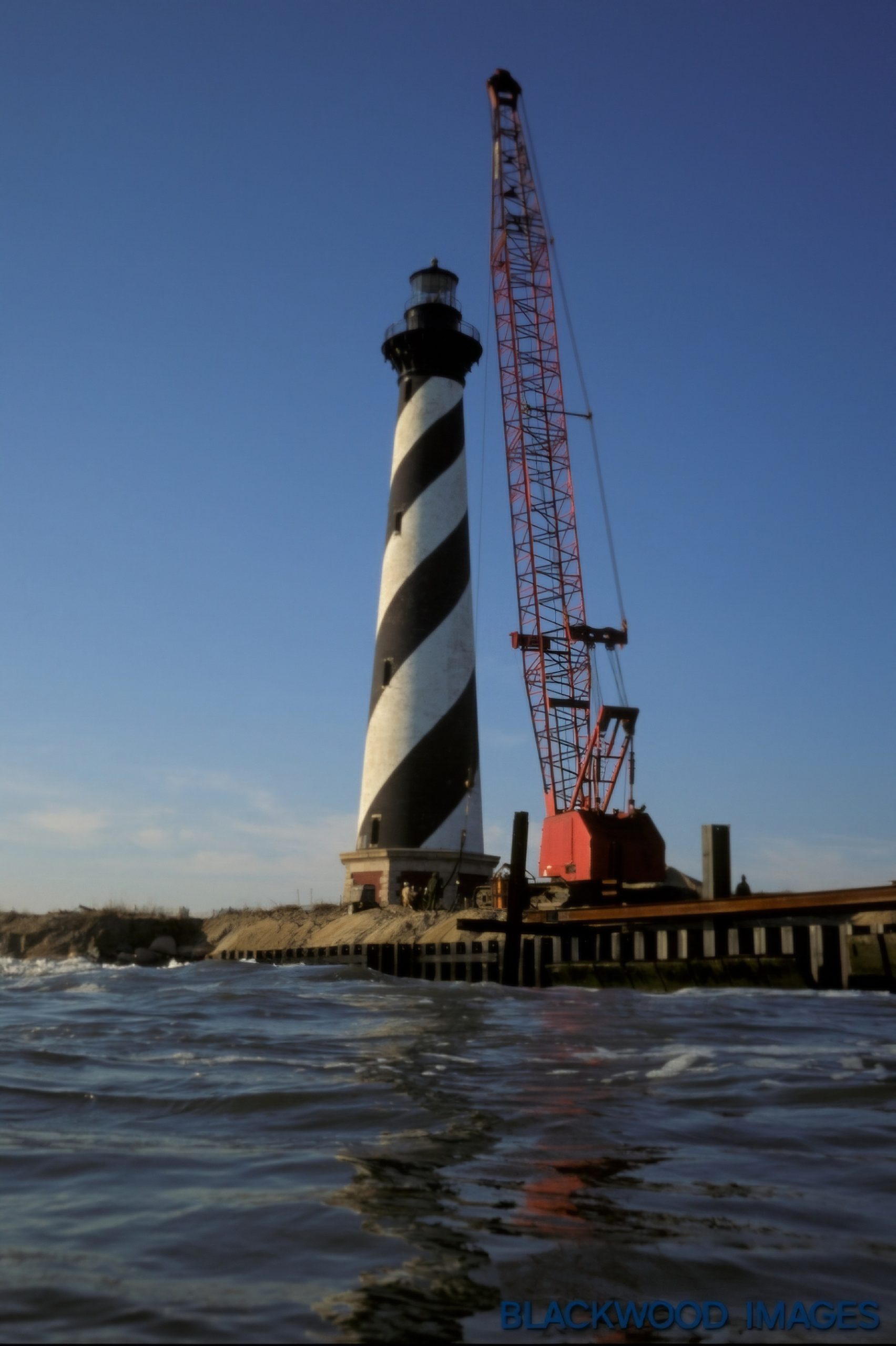
But there have been some adjustments or variances to these rules. Exceptions have been made to protect historic, unmovable structures, or important waterways needed for navigation. Most notably, in 2011, North Carolina Senate Bill 110 (S.L. 2011-387) became law, repealing the decades-old ban on hardened structures by allowing up to four “test” terminal groins to be built in North Carolina.
Close to home, when the Cape Hatteras National Seashore was developing its Sediment Management Framework in the early 2020s, there was a discussion with Dare County officials about potentially repairing the Buxton jetties.
Under the current law, if there is an existing, grandfathered-in jetty or other hardened structure, and 50% or more of it still exists, it can be repaired. If there’s less than 50% of the original structure remaining, it’s considered a total rebuild or replacement, which is not allowed.
After an early 2020s study by Coastal Science and Engineering (CSE), it was determined by the state that there was not enough of the Buxton jetties left to qualify for a repair variance.
“We had explored it before then, and it was discussed and talked about several times, but each time the 50% rule was an impediment,” said County Manager Bobby Outten.
In the 382-page final Sediment Management Framework, published in 2021, jetties are mentioned as an alternative that was considered but dismissed in regard to sediment management and shoreline protection.
“No special use permit applications have been received or are anticipated to be received in the near future for new groins or jetties,” reads the report. “Additionally, the construction and rehabilitation of groins and jetties along ocean shorelines and outside of Seashore boundaries are currently limited by state law (GS 113A-115.1), and it is unlikely that the State would permit these structures at this time, rendering this alternative element technically infeasible.”
“Dare County has done a lot of work to look into this and evaluate whether or not this is something they can do, and get permission from the state of North Carolina to do,” said David Hallac, National Parks of Eastern N.C. Superintendent.
So, the conversation has come up before, and has hit a wall in the past, but the BCA is tackling the question once again, in an effort to examine all possible options when it comes to protecting Buxton Beach.
How could rebuilding the jetties work?
Like many projects on Hatteras Island, if repairing or replacing the Buxton jetties were to come to fruition, there would be a lot of local, state, and federal organizations weighing in along the way.
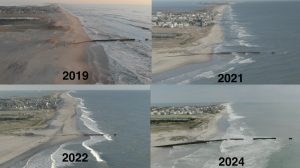
Essentially, because Buxton is part of a National Seashore, a detailed proposal and special use permit application would need to be submitted to the National Park Service that outlines the specs of the project involved so it could undergo the environmental planning review process.
This process, which is used for everything from the ORV Management Plan to the recent construction of the Cape Hatteras Lighthouse Pathway, has multiple steps, such as consulting with stakeholders, and collecting public input and feedback.
“This whole topic needs to be discussed more between the county, the Park Service, and the state, as well as the local community,” said Hallac. “There would be multiple other agencies involved. If another jetty was built, it may be [partially] on state land, so North Carolina would have input. Army Corps of Engineers would most likely be involved because of drilling, and all the other state and federal regulatory agencies would also have to permit and/or approve.”
And the proposal itself would need to be backed by ample research.
“We are now 50 years past the implementation of those jetties, and it’s prudent to take a fresh look at the problem and their viability, versus just doing the same thing that we did before,” said Hallac.
In other words, would the jetties land in the same location, or would shoreline changes over the past 50 years dictate a new, more effective placement? How much would they cost, and what would be the return on investment?
“You’d need a pretty in-depth [study] on cost, size, location, benefits, and you’d want to get as much information as possible on the coastal geological area to determine if this is something that is worth investing in, and if so, how to move forward.”
For example, groins were once bounced around as an idea to protect northern Rodanthe homes from collapsing. But if groins were built in this one area of Rodanthe, (with a roughly $15 million price tag), the shorelines that border communities south of the groins would be scalloped and depleted of sand, causing a new wave of problems.
While the jetties in Buxton have historically not caused similar issues to surrounding communities, there is still a lot of legwork required to determine if and/or how they would best protect the shoreline.
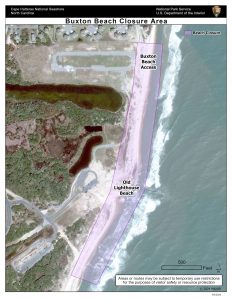
“We don’t have a stance on this because there is no proposal yet,” said Hallac. “What’s important in this situation, for all parties involved, is to figure out what the objective is of managing the beach in Buxton. It’s clear and obvious that the village and N.C. Highway 12 needs to be protected. If that’s the objective, then the question is, what do we do, and how do we do it?”
In addition to stakeholder input, replacing the jetties naturally runs into the hurdle of the statewide ban on hardened structures.
“Right now, the N.C. General Assembly has the ability to permit up to six terminal groins on the terminus of an island,” said Tancred Miller, Division of Coastal Management Director. “For the middle of an island, the current law doesn’t allow for [groins.]”
“So [for Buxton], it would require a law change. Our commission can grant variances, but not grant them outside of state law.”
Miller noted that while there was no wiggle room right now when it came to a variance from the Division of Coastal Management, a change in state law would alter the current restrictions.
“Of course, that law can be changed if anyone wants to change it,” he said. “If they were given authority by the General Assembly, they could move forward.”
Simply put, if the Buxton jetties were to be revitalized, there would be some big hurdles to overcome, which might include a change in the state law. But the BCA – encouraged by the ongoing action by the USACE to clean the beach – is undaunted in getting a Buxton jetties project off the ground.
The massive response by the audience at their NCBIWA conference presentation last week has only fueled their ambition to bring the Buxton jetties back into local and statewide conversations.
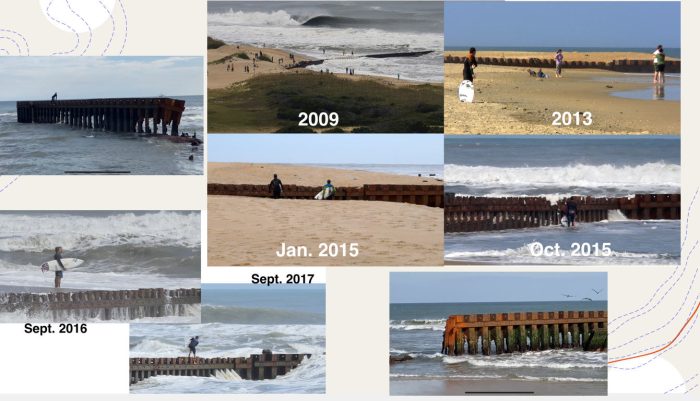
The response “was overwhelming”
At the end of the BCA presentation, Barley shared photos of the jetties’ deterioration over the last 50 years.
“As a surfer, my friends and I – and those that frequent the area and surf there all the time – know that in 2015, the flow of water through the groins was changing. It used to be a place where you could paddle out alongside of it, and the groins stopped the downshore current… and that wasn’t happening anymore.
“We didn’t know why until later that year and into 2016, when we realized that holes were forming underneath the water level, all through the jetties.”
The deterioration has only accelerated in the past few years, according to Barley and the surfers who are right next to the jetties on a regular basis.
“In 2021 we lost a solid chunk,” said Barley, noting that more holes were also rapidly forming in the groins, under the water’s surface. “We had a [beach] nourishment project in 2022 and it did not last as long as the 2017 [beach nourishment project], because there was nothing there to hold it.”
“I would actually argue that in the last two months, what we’ve seen is that the holes are actually exacerbating the erosion, because the water is hitting them and flowing through them faster than if they weren’t even there,” he said. “So, something that was a solution is now turning into a problem, because it’s not being maintained.”

Barley argued that when the jetties were functional and at their peak, they helped keep the beach from disappearing.
“The Navy showed up and built these – we did not have a choice – but they showed that it worked,” said Barley. “It lasted for 40 years, and now we’re at a point where something can be done.”
After the presentation, and a series of questions, the BCA representatives were flooded by folks in the audience who were shocked at the ongoing issues surrounding Buxton.
“The response was overwhelming. I think most people were surprised, because they had never heard about Buxton Beach before,” said Jennette. “This was the first time many of them were hearing about what’s happening, and we’ve just been living it for more than a year.”
Jennette and Harris both said that it took them more than 30 minutes to leave the room after the presentation, simply because people kept coming up to them and asking how they could help.
Conversations were ongoing throughout the conference, with many new connections formed with legislators, engineering firms, neighboring towns, and multiple organizations who wanted to help the BCA move the ball forward.
“We were just flooded with people coming up to us with ideas, and asking how they could help,” said Harris. “It was unbelievable.”
“I’ve never had as little or no pushback as we did after that presentation, ever,” said Dawson. “And not only were we not getting pushback, we were getting support from every direction… it was energizing.”
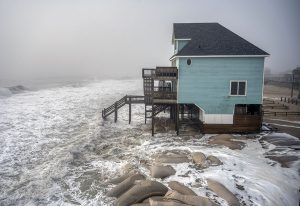
On the heels of an event that brought Buxton Beach onto the statewide radar, generating unprecedented buzz and support from organizations that are new to the issue, the BCA is optimistic about what will come next.
Examining the replacement of the Buxton jetties – and how to move forward – is clearly the BCA’s next goal.
“We’ve been having this conversation behind closed doors with Dare County officials, coastal engineering companies, and a lot of the players in this game who are making these decisions,” said Harris. “Nobody wants to see Buxton wash away, and it could be the first town to disappear on the East Coast… So, we’re getting ready to open a Pandora’s Box.”
Regardless of what’s next, and how Buxton Beach is cleaned up, remediated, stabilized, and eventually reopened, the BCA is open to anyone who wants to come to the table and help.
And after last week’s conference, there are clearly a lot more new voices who want to join in the conversation.
“We have to continue to push the momentum. What we went down there and did worked. We laid out the case for beach stabilization, and people listened and responded,” said Dawson. “This is the best chance we’ve ever had to make things happen.”
*(Note that there are definitional and state law differences between jetties and groins, as outlined by this explanation from CoastalReview.org.)



